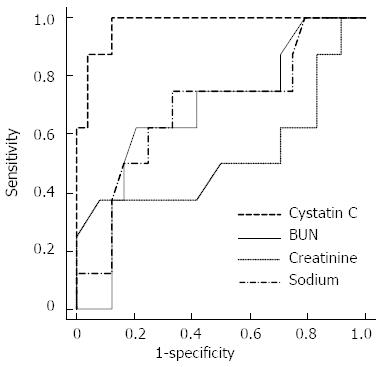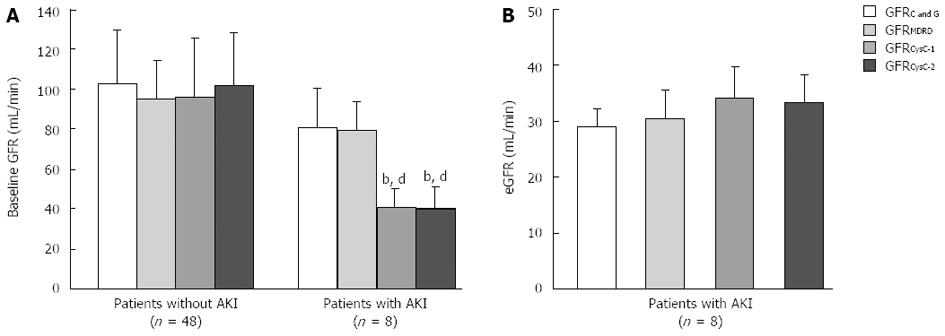Copyright
©2013 Baishideng Publishing Group Co.
World J Gastroenterol. Dec 28, 2013; 19(48): 9432-9438
Published online Dec 28, 2013. doi: 10.3748/wjg.v19.i48.9432
Published online Dec 28, 2013. doi: 10.3748/wjg.v19.i48.9432
Figure 1 Scatter plots.
A: Serum cystatin C (CysC) level vs model for end-stage liver disease (MELD) score; B: Serum CysC level vs serum creatinine (Cr) level.
Figure 2 Receiver operating characteristic curve.
Receiver operating characteristic curve analysis was performed to compare the efficacy of serum cystatin C, creatinine, blood urea nitrogen (BUN) and serum sodium level in predicting acute kidney injury.
Figure 3 Performance of four equations for measuring estimated glomerular filtration rate in patients with acute-on-chronic liver failure.
A: Baseline estimated glomerular filtration rate (eGFR) between patients with or without acute kidney injury (AKI); B: Comparison of four eGFR values in patients with AKI. eGFRCG: The Cockcroft and Gault formula; eGFRMDRD: The modification of the diet in renal disease equation; eGFRCysC-1: Cystatin C-based Hoek estimate; eGFRCysC-2: Chronic Kidney Disease Epidemiology Collaboration cystatin C equation. bP < 0.01 vs GFRcysC in patients without AKI; dP < 0.01 vs e-GFRCG, and e-GFRMDRD in patients with AKI.
- Citation: Wan ZH, Wang JJ, You SL, Liu HL, Zhu B, Zang H, Li C, Chen J, Xin SJ. Cystatin C is a biomarker for predicting acute kidney injury in patients with acute-on-chronic liver failure. World J Gastroenterol 2013; 19(48): 9432-9438
- URL: https://www.wjgnet.com/1007-9327/full/v19/i48/9432.htm
- DOI: https://dx.doi.org/10.3748/wjg.v19.i48.9432











